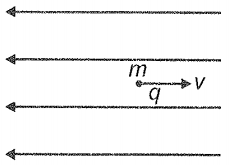A neutral bubble made of soap solution has radius R. If some negative charge is given which gets distributed uniformly on the surface of the bubble, the radius of the bubble becomes R' then
1. R' > R
2. R' = R
3. R' < R
4. R' = 0.5 R
A large non-conducting sheet S is given a uniform charge density. Two uncharged small, metal rods A and B are placed near the sheet as shown in the following diagram. Choose the incorrect option:
1. S attracts A.
2. S attracts B.
3. A attracts B.
4. S repels A.
An electric dipole is placed at the centre of a sphere. Which of the following statements is correct?
| 1. | The electric flux through the sphere is zero. |
| 2. | The electric field is zero at every point on the sphere. |
| 3. | The electric field is zero at every point inside the sphere. |
| 4. | The electric field is uniform inside the sphere. |
A particle with charge +ve and mass m is projected with velocity v in the opposite direction of a uniform electric field E as shown in the figure in a gravity-free space. After what time the velocity will become -v?

1.
2.
3.
4.
Which of the following statements is correct about a dipole in a non-uniform field?
1. Torque is always nonzero
2. Net force may be nonzero
3. Torque is always zero
4. Net force is always zero
A particle of mass m has a charge when it is at rest. When the particle moves with speed v, the charge on the particle will become (c is the velocity of light in vacuum)
1.
2.
3.
4.
Starting from rest an electron moves through a small distance in a uniform electric field of magnitude . The direction of the field is reserved keeping the magnitude unchanged and a proton moves through the same distance. The time of motion will be
1. Same in both cases
2. More in the case of an electron
3. More in the case of proton
4. Independent of charge
A source charge Q is kept at a distance of 3 km from a test charge . If Q is displaced slightly, then the change in the electric field detected by will be after
1. 10 s
2. 10 ms
3. 10 s
4. 10 ns
Two-point charges -q and +9q are kept at r = 12 cm apart as shown. The electric field is zero at:
1. 6 cm from point A toward B
2. 3 cm from point A opposite to B
3. 9 cm from point B towards A
4. 18 cm from the point B towards A
Two-point charges \(+2~\mu\text{C}\) and \(+6~\mu\text{C}\) repel each other with a force of \(60~\text{N}\). If a charge \(-4~\mu\text{C}\) is added to each of them, the force between them will become:
1. \(60~\text{N}\)
2. \(360~\text{N}\)
3. \(20~\text{N}\)
4. \(40~\text{N}\)








